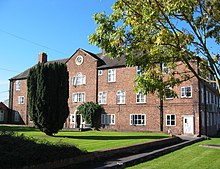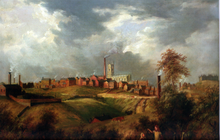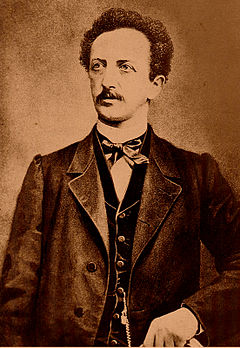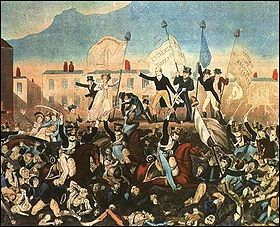Speenhamland Legislation
The Speenhamland system was a kind of social law in England in the years between 1795 and 1834. The Speenhamland system consisted of a fixed amount of poor support, which either in full to the needy or in addition to wages (cf. combined wages ) to workers with accordingly was paid at low wages.
Historical starting point

Since 1601 there has been a law on the poor in England based on the distinction between the needy through no fault of their own who were placed in poor houses , the unemployed through no fault of their own, for whom there were workhouses , and “beggars” or “vagabonds” for whom the reformatory or even prison was intended . Since these closed facilities of the respective commune (" parish ") could be expensive to set up, there was also a poor support in the form of money, food, clothing or fuel, which could also be given to the poor outside of these facilities.
With the Poor Relief Act of 1662, also known as the "Settlement Act", the free movement of the population was restricted to the extent that the home municipality was exclusively responsible for this aid under the Poor Law, which also covered the costs of repatriation someone else's poor who had become in need of help.
The necessary contributions to the poor fund were initially levied as local income tax , but later increasingly as a levy on property, which was not only paid by landowners, but also e.g. B. was also to be paid by tenants.
Speenhamland: functionality and content
The Speenhamland system is named after the location of a meeting of local justices of the peace in Speenhamland, Newbury (Berkshire) , who met on site in an inn for passing officials, politicians and military, the Pelican Inn.
At that time, justice of the peace, as the local lower administrative authority, was responsible in disputes for the decision on the granting of poor relief by a municipality, as well as for the compulsory collection of locally determined contributions to the poor fund and the supervision of the bookkeeping of the same.
On the occasion of the above-mentioned meeting on May 6th, 1795, it was decided that the poor relief should be adjusted to the development of the bread price and also depend on the number of people to be supported in the household. A “hard-working man” should receive the equivalent of the price of three loaves of bread (8 lb. 11 oz. Each, i.e. about 4 kg each) and the equivalent of the price of an additional loaf of bread for each additional family member. A married man with two children should therefore receive 3 shillings 9 pence for himself (at a price for a loaf of bread of 1 shilling 3 pence) and an additional 1 shilling 9 pence each for a wife and children, for a total of 9 shillings .
The Speenhamland system therefore consisted of a standardization of poor support (for poor people living outside of closed institutions) in a form of help that was paid in money and flexibly adapted to the (bread) price development. This should have facilitated the test of need as such; Benefits in kind have become dispensable and the co-payment with wages has been simplified.
Economic background
industrialization

The beginning of industrialization in England was initially based on only one branch of production, namely the production of cloths. Here, too, the degree of real mechanization was comparatively low. Beginning with the invention of the spinning jenny in 1764, the spinning of the yarn could be significantly rationalized, but the subsequent process of cloth weaving on the loom was still manual work, which was organized either at home or later in factories. This narrow base of industrialization became a problem after growing competition arose on the continent, in which only the yarn was imported from England, but this was then processed into cloth on the spot. Sales markets also collapsed as a result of the coalition wars against France, and especially the continental blockade. This put considerable pressure on workers' wages.
Through the substantially completed at the end of the 18th century process of containment of land for grazing and the depression of the rural population to day laborers or marginal farmers was for this more no way to compensate for wage loss and / or to secure their subsistence elsewhere.
Agricultural crisis
At the same time, a large part of the population was still employed in agriculture, the productivity of which was still comparatively low. The failure of food imports and / or a bad harvest domestically could therefore lead to rapidly rising prices for food.
Rural exodus
The descent of peasants to smallholders or landless day laborers and the - albeit perhaps small - prospects for work in the developing regions of early industrialization favored rural exodus .
Furthermore, the incipient rationalization of production through the division of labor, as propagated for example by Adam Smith in the first chapter of his well-known main work “ The Prosperity of Nations ”, limited the possibility of home work and required the worker to be close to the company location.
The coincidence of these different developments of a classic agricultural crisis of overpopulation and poor harvest with the first pre-industrial recessions then led to the mass poverty in the population known as pauperism . This sometimes overstrained the capacity of the existing closed facilities, such as the workhouses, and favored the standardization of poor relief for the poor living outside these facilities. The Speenhamland system reacted to this by standardizing the rates for poor relief and linking them to the price of bread. At the same time, this was intended to counteract the tendency towards rural exodus, since the poor support was still only to be provided by the home community.
Effect and criticism
Social conflict
The Speenhamland system can be seen as an administrative simplification within the framework of already existing poor law (see above: historical starting point ). As a regulation aimed purely at the subsistence level, a pacification of social conflicts could of course not be expected. Still, the Speenhamland system was not unpopular with beneficiaries in southern and central England. A legislative proposal by William Pitt the Younger of 1796 to make the Speenhamland system nationally binding failed, however.
Contemporary criticism

The contemporary criticism of the Speendhamland system was often at the same time one that ignited the traditional "Old Poor Law" of Elizabethan law since 1601. The work of Sir Frederick Eden "State of the Poor" from 1797, who attested the poor law as follows, was influential here:
"A man 'may have been indolent, improvident, prodigal, or vicious [but] he shall never suffer want'."
Contemporary and influential criticism also came from Thomas Robert Malthus ("An Essay on the Principle of Population" - Eng. "The Population Law " of 1798) and - argued differently, but with similar conclusions - from David Ricardo . In his successor, for example, Ferdinand Lassalle argued in terms of an iron wage law , according to which the wage level generally falls to the subsistence level as the population grows (labor supply) and, conversely, the wage level only rises above it as the population decreases. This of course raises the question of the possibility and usefulness of social policy measures. One of the contemporary critics of the traditional law of the poor also included - following the utilitarianism of Jeremy Bentham and the principle of "the greatest possible happiness of the greatest possible number" - Edwin Chadwick . It was criticized here that the poor relief - without really helping the poor - only burdens the rich. The criticism that the poor relief has lost its “shameful” and “humiliating” character was also not untypical.
Review by Karl Polanyi
In his work The Great Transformation, Karl Polanyi describes the (utopian) attempt to create a self-regulating market system outside and otherwise free of social ties. Part of this development is to transform “work” into a tradable product (English “commodity”). In this context, Polanyi analyzes the contradicting regulations and effects of the Speenhamland system.
The Speenhamland system was linked to the expectation of an increase in wages above the subsistence level. The opposite seems to have happened, since it was worthwhile for employers to lay off salaried wage laborers and employ poor people who were paid from the municipal coffers in their place. In this respect, the Speenhamland system even had a wage-reducing effect and promoting poverty. At the same time, this had negative effects on labor productivity.
Since those in possession were generally liable to pay contributions to the poor fund (see above historical starting point ), there was in fact cross-subsidization from the poor fund in favor of those employers who employed many poor people (e.g. larger landowners) by those employers who were subject to contributions but only a few employees had (e.g. self-employed small craftsmen). It cannot be ruled out that small entrepreneurs themselves may find themselves in need as a result of the contributions due to the poor.
The Speenhamland system immobilized the unemployed rural population, as they had to live in their home commune to receive support. This has hampered the development of a national labor market. Meanwhile there was migration to the communities with functioning poor relief.
Abolition and "New Poor Law" 1834
The Speenhamland system was abolished together with the poor law developed since 1601 and replaced by the "Poor Law Amendment Act" of 1834, called the "New Poor Law". The core of the new law was the abolition of any kind of poor relief for the able-bodied poor living outside of closed facilities (outdoor relief) and - in return - the nationwide creation of appropriate workhouses (indoor relief). So that each of the 15,000 municipalities did not have to build a workhouse, they were merged into administrative units for the application of poor law (like a special purpose association ). The municipalities bore the costs for this, depending on their own previous expenditure on poor relief.
See also
literature
- Yannick Vanderborght & Philippe van Parijs : A basic income for everyone? History and future of a radical proposal. Campus-Verlag, Frankfurt / New York 2005, ISBN 3-593-37889-2 , p. 16 f.
-
Karl Polanyi : The Great Transformation. 1944
- The great transformation. Political and economic origins of societies and economic systems. Suhrkamp, Frankfurt 1978, ISBN 3-518-07860-7
- Rainer Hank : In the devil's mill. A balance sheet of the welfare state. In: Mercury . No. 736/737, September / October 2010
Web links
Individual evidence
- ↑ On this and the following: http://www.workhouses.org.uk/poorlaws/oldpoorlaw.shtml
- ↑ http://www.historyandpolicy.org/policy-papers/papers/englands-early-big-society-parish-welfare-under-old-poor-law
- ↑ http://www.workhouses.org.uk/poorlaws/oldpoorlaw.shtml#Speenhamland
- ↑ For comparison: John Foster, Class Struggle and the Industrial Revolution, London 1974, p. 82, refers for the years 1800 to 1820 for cotton spinners in the spinning mills to a weekly average wage of about 10 to 12 shillings and for simple shoemakers in Northampton around 1790 (before the economic effects of the coalition wars ) from 10 to 15 shillings (ibid., p. 87).
- ^ John Foster, Class Struggle and the Industrial Revolution, London 1974, pp. 20f.
- ^ For shoe production in Northampton, see : John Foster, Class Struggle and the Industrial Revolution, London 1974, pp. 86f.
- ↑ Karl Polanyi , The Great Transformation , Frankfurt 2015, p. 129; see. also: John Foster, Class Struggle and the Industrial Revolution, London 1974, p. 63.
- ↑ Cf. on this: "Machine Striker" in England.
- ↑ Philippe Van Parijs / Yannick Vanderborght, Basic Income: A Radical Proposal for a Free Society and a Sane Economy, Harvard 2017, p. 57
- ↑ Translated: A man 'may be sluggish, careless, wasteful or vicious, [but] he should not suffer hardship.' Quoted from: Philippe Van Parijs / Yannick Vanderborght, Basic Income: A Radical Proposal for a Free Society and a Sane Economy, Harvard 2017, p. 58
- ↑ References in Philippe Van Parijs / Yannick Vanderborght, Basic Income: A Radical Proposal for a Free Society and a Sane Economy, Harvard 2017, pp. 59f.
- ↑ See also on the criticism of the myth of a primordial market barter trade as a human condition: David Graeber , Debt: The First 5,000 Years, New York / London 2011, pp. 21ff.
- ↑ On this and the following: Karl Polanyi, The Great Transformation, Frankfurt 2015, p. 113ff.
- ↑ http://www.workhouses.org.uk/poorlaws/newpoorlaw.shtml

